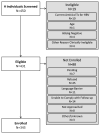Children with Chronic Hepatitis B in the United States and Canada
- PMID: 26364985
- PMCID: PMC4662884
- DOI: 10.1016/j.jpeds.2015.08.021
Children with Chronic Hepatitis B in the United States and Canada
Abstract
Objectives: To test the hypothesis that children with chronic hepatitis B living in the US and Canada would have international origins and characteristic hepatitis B virus (HBV) genotypes and laboratory profiles.
Study design: Clinical characteristics of children enrolled in the Hepatitis B Research Network were collected from 7 US and Canadian centers.
Results: Children (n = 343) with an age range of 1.0-17.8 years were enrolled; 78% of the children were Asian, 55% were adopted, and 97% had international origins with either the child or a parent born in 1 of 31 countries. The majority had HBV genotype B (43%) or C (32%), and the remainder had genotype A (5%), D (16%), E (4%), or multiple (<1%). Children with genotype B or C were more likely to be Asian (98% and 96%), more consistently hepatitis B envelope antigen positive (95% and 82%), had higher median HBV DNA levels (8.2 and 8.3 log10 IU/mL), and less frequently had elevated alanine aminotransferase values (43% and 57%) compared with children with other genotypes. The percentage of hepatitis B envelope antigen positivity and of those with HBV DNA ≥6 log₁₀ IU/mL declined with age.
Conclusions: The majority of children in the Hepatitis B Research Network have HBV genotypes that reflect their international origins. Clinical and laboratory data differ substantially by patient age and HBV genotype. Use of these data can help drive the development of optimal strategies to manage and treat children with chronic hepatitis B.
Copyright © 2015 Elsevier Inc. All rights reserved.
Figures




Comment in
-
Two Key Components to Address Chronic Hepatitis B in Children: Detection and Prevention.J Pediatr. 2015 Dec;167(6):1186-7. doi: 10.1016/j.jpeds.2015.09.015. Epub 2015 Sep 26. J Pediatr. 2015. PMID: 26409308 No abstract available.
References
-
- Bortolotti F, Calzia R, Cadrobbi P, Giacchini R, Ciravegna B, Armigliat M, et al. Liver cirrhosis associated with chronic hepatitis B virus infection in childhood. J Pediatr. 1986;108:224–7. - PubMed
-
- Hsu HC, Wu MZ, Chang MH, Su IJ, Chen DS. Childhood hepatocellular carcinoma develops exclusively in hepatitis B surface antigen carriers in three decades in Taiwan. Report of 51cases strongly associated with rapid development of liver cirrhosis. J Hepatol. 1987;5:260–7. - PubMed
-
- Chang MH. Decreasing incidence of hepatocellular carcinoma among children following universal hepatitis B immunization. Liver Int. 2003:23309–14. - PubMed
Publication types
MeSH terms
Grants and funding
LinkOut - more resources
Full Text Sources
Other Literature Sources

